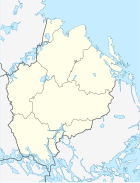Enkoping
| Enkoping | ||||
|
||||
| State : | Sweden | |||
| Province (län): | Uppsala län | |||
| Historical Province (landskap): | Uppland | |||
| Municipality : | Enkoping | |||
| Coordinates : | 59 ° 38 ′ N , 17 ° 6 ′ E | |||
| SCB code : | 0532 | |||
| Status: | Crime scene | |||
| Residents : | 22,553 (December 31, 2015) | |||
| Area : | 10.5 km² | |||
| Population density : | 2148 inhabitants / km² | |||
| List of perpetrators in Uppsala County | ||||
Enköping is a city in the Swedish province of Uppsala län and the historic province of Uppland . Enköping is also the capital of the municipality of the same name .
geography
The city is located at the mouth of the Enköpingså River and Lake Mälaren , about 77 km northwest of Stockholm and 42 km southwest of Uppsala . It extends partly on a sandy moraine and partly on the ground that the river has washed up. The area is characterized by wide plains, some of which are swampy. For a long time the river in the southern part of the city was divided into two arms, but the western arm is now just a small trickle.
history
The settlement first arose on the eastern side of the river. Their exact age is not proven by written sources. Probably there was an Iron Age sacrifice and a trading place here. There is also evidence of the existence of a 5th century court square. After Christianization there was a Catholic provost in the village at the end of the 12th century , who at that time was written Enescopinge . Enköping has housed a Franciscan monastery since 1267 and over time three churches were built, including today's Church of Our Lady ( Vårfrukyrkan ). A bourgeoisie slowly emerged, so that at the end of the 14th century a mayor was mentioned. In the following century, Enköping received privileges from various rulers, but the originals were lost in a conflagration. Charles VIII and Sten Sture the Elder held several meetings in the city to discuss the development of the surrounding countryside.
In 1572 a huge fire destroyed parts of the city and in 1580 Enköping was struck by the plague , which is said to have claimed 6,000 victims in the parish. This number is questioned, however, as the city three centuries later had about the same number of inhabitants despite positive development. King Gustav Wasa had the monastery and all other church property move in. The monastery buildings then housed a hospital and various factories.
The trade with the provinces of Västmanland and Dalarna , whose metal products were transported to Stockholm and Södertälje, was decisive for the development of the place . Under King Charles IX. Enköping received scales and a customs house and after another fire in 1609 the king ensured that trade flourished again. Gustav II Adolf , on the other hand, had the goods diverted from the Bergslagen region to Västerås . Nevertheless, Enköping retained its important position in Swedish trade for a long time.
By the mid-17th century, the streets were narrow and winding, following the meanders of the river. Today's Kungsgatan was laid out during the construction of the road from Stockholm to Västerås . However, this was not always the same width and went over a steep hill in the east. It was not until the 19th century that the major deficiencies in the street were eliminated. At that time the representative buildings of the city, such as churches and town hall, were made of stone, the rest of the houses were made of wood.
With the decrease in the iron trade, the city received the right to supply the royal family with vegetables. For this purpose, vegetable farmers from Holland were recruited to help the town build up the new industry. At the beginning of the 18th century people tried to plant tobacco , but in the end the town became known for its horseradish fields .
Today the city is known to garden lovers across Europe and enjoys a reputation comparable to that of English gardens. Every year tens of thousands of perennials are planted in Enköping in spring, the cityscape is characterized by numerous pocket parks and green areas. This commitment considerably reduces carelessness and vandalism; The population and tourists benefit from the increased quality of the urban social space. The "dream garden" was designed between 1996 and 2003 by Piet Oudolf . The area is shaped by three blocks of beech wood. The planting is dominated by blue ornamental sage : Salvia nemorosa 'Ostfriesland', Salvia x 'Blauhügel' and Salvia x 'Rügen'. There is also the usual red water can, mullein and man litter .
Personalities
sons and daughters of the town
- August Nilsson (1872–1921), sportsman
- Josef Jonsson (1887–1969), composer
- Ragnar Wicksell (1892–1974), football player
- Amelia Andersdotter (* 1987), politician
- Sebastian Rajalakso (* 1988), football player
literature
- Claudia Beindorf: Enköping - gardens and parks in Mälardalen . In: Stefan Kaufmann (Ed.): Orders of the landscape. Designing nature and space symbolically. Ergon, Würzburg 2002
Web links
swell
- ↑ a b Statistiska centralbyrån : Land area per Tatort, folkmängd and invånare per square kilometer. Vart femte år 1960 - 2015 (database query)
- ^ Piet Oudolf, Noel Kingsbury: Landscapes in Landscapes. London, Thames and Hudson 2011, pp. 84-91


